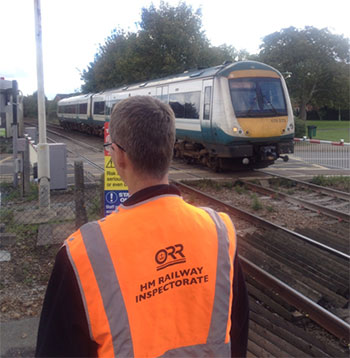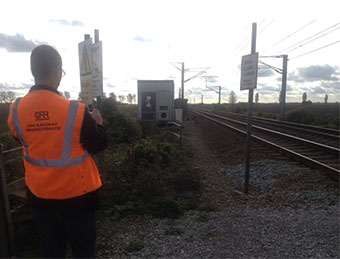Content archived on 2 July 2021
It's now over a decade since I began working for HM railway inspectorate, as it was then known, now part of the Office of Rail Regulation (ORR). As the principal inspector for Network Rail in south east England, I lead a team of seven inspectors who spend the majority of their time out, away from the office, protecting the safety of those working on and travelling on the rail network.
 Over the past 12 years I have seen first hand some significant improvements in safety, fewer passengers and workers are coming to harm, with fatality rates well below the European average. Britain is also now ranked best at managing passenger and level crossing safety.
Over the past 12 years I have seen first hand some significant improvements in safety, fewer passengers and workers are coming to harm, with fatality rates well below the European average. Britain is also now ranked best at managing passenger and level crossing safety.
While Britain's railway is now statistically one of Europe's best, I can't be complacent about how good things are as I have investigated too many tragic incidents, prosecuted companies for breaches of law, and had to take enforcement action to force improvements. I believe there is still plenty of scope for improvement.
It's the evidence I and my colleagues see when out on the railways that counts, and already this financial year, ORR inspectors have spent over 41,000 hours on frontline inspection activities, scrutinising the day to day operations of trains, Network Rail's management of the infrastructure and the behaviour of rail construction companies.
When on an inspection, I want to see evidence the rail industry is managing safety proactively, spotting potential issues before they impact on safety, or require me to step in. I find it's often the smallest changes, which can have the biggest impact.
On a recent inspection at a footpath level crossing in the Anglia region, I found two warning signs were obstructing pedestrian's views of oncoming trains. This is obviously not good practice at a crossing where members of the public are responsible for deciding the safest moment to cross. Although, I've asked Network Rail to move the signs to more appropriate locations, the company really should be identifying these issues themselves.
 Over the next five years, we are paying particular attention to Network Rail's management of assets, an issue central to safety and the reduction of delays experienced by passengers. After setting Network Rail new targets for improved asset knowledge and data quality, we are closely monitoring the company's performance. In the south east, I have been concerned to see Network Rail report an increase in the number of track faults. While the safety risks of these is being managed (for example through speed restrictions) we are currently scrutinising the company's management of track maintenance, interviewing rail workers, reviewing maintenance records and physically checking the condition of the track to ensure that there is no compromise on safety.
Over the next five years, we are paying particular attention to Network Rail's management of assets, an issue central to safety and the reduction of delays experienced by passengers. After setting Network Rail new targets for improved asset knowledge and data quality, we are closely monitoring the company's performance. In the south east, I have been concerned to see Network Rail report an increase in the number of track faults. While the safety risks of these is being managed (for example through speed restrictions) we are currently scrutinising the company's management of track maintenance, interviewing rail workers, reviewing maintenance records and physically checking the condition of the track to ensure that there is no compromise on safety.
In addition, ORR's on-going programme of targeted inspections is focussing on Network Rail's station management, electrical and worker safety, level crossings and the condition of tracks, bridges and tunnels.
All of this means that as an Inspector, I have a challenging, varied and very rewarding job, ensuring that those responsible make Britain's railways safe for passengers and provide a safe place for staff to work.
You can read more about Tom Wake's recent inspection when he was accompanied by Paul Geater from the East Anglian Daily Times.

